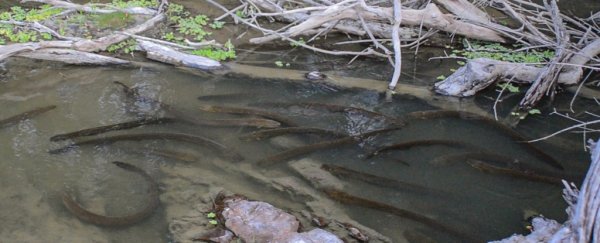Electric eels appear to not be the loners we thought they were.
In a small lake deep in the Amazon River basin in Brazil, scientists have for the first time recorded the fish not just living together, but actively working together to forage, and to bring down their prey.
There's even evidence that the strategy is working. Of the plentiful Volta's electric eels (Electrophorus voltai, not a true eel but a type of knifefish) found living in the lake, many were over 1.2 metres (4 feet) in length and thriving.
"This is an extraordinary discovery," said ichthyologist Carlos David de Santana of the Smithsonian Institution's National Museum of Natural History. "Nothing like this has ever been documented in electric eels."
Not much is known about Volta's electric eel. The fish was only recently discovered in a lake along the Iriri river, and officially described and recognised as a distinct species last year. But it packs a punch, able to discharge a single shock in excess of 860 volts – more powerful than any other electric eel on record.
De Santana and his team first observed the electric eels hunting in a group in 2012. Over 100 individuals seemed to work together to herd and kill prey so that the entire shoal could feed. But one observation wasn't enough to classify the hunt as normal behaviour.
In 2014, the team returned and found even more Volta's electric eels, so they got to work observing and recording the animals. Over 72 hours of continuous observation, they saw the electric eels engage in five more hunts. Not only was this enough to classify the behaviour as normal, it allowed the researchers to observe and record exactly how these "social predation events" occur.
During the day and night, the electric eels mostly rested. At dusk and dawn, the twilight hours, the electric eels stirred themselves to hunt. This, the team noted in their paper, is unusual: Typically, Volta's electric eels are only observed foraging at night and solo.
The difference here is striking. On each occasion, over 100 individual electric eels aggregated and started swimming in circles, effectively herding groups of smaller fish, mostly characins, into a "prey ball" that they gradually chivvied into shallower waters.
Then, once the prey ball was tightly corralled with nowhere to go, up to 10 of the electric eels moved forward and launched a powerful joint strike, stunning the prey – which would jump out of the water before falling back down, senseless.
"If you think about it, an individual of this species can produce a discharge of up to 860 volts – so in theory if 10 of them discharged at the same time, they could be producing up to 8,600 volts of electricity," de Santana speculated. Of course, electric eels don't function as precisely as electrical wiring in our homes.
Once the prey was stunned, the shoal could move in and feed at leisure.
Each hunt, the team found, took around an hour and involved five to seven electrical strikes.
"Hunting in groups is pretty common among mammals, but it's actually quite rare in fishes," de Santana said. "There are only nine other species of fishes known to do this, which makes this finding really special."
Nevertheless, while the hunts may be normal, the team still believes they could be pretty rare. In their interviews with locals, the electric eels' congregation and hunting behaviour wasn't mentioned. So, whether the electric eels gather to hunt or go solo could be dependent on the right conditions, such as high prey abundance, and specific locations with lots of shelter for large numbers of these fish.
While a lot is still unknown, the team believes the electric eels likely return to the lake on an annual basis. They have launched a citizen science project called Projeto Poraquê, where locals can log observations; those data could prove invaluable. And the team is planning to return to the location in the hope of observing the animals again.
"In addition to trying to locate additional populations of eels involved on group foraging, our future field- and laboratory-based studies will investigate social predation in electric eels focusing on the link between population, social structures, genomics, and electrogenesis," they wrote in their paper.
"In short, this case offers a unique perspective for future studies on the evolutionary interplay between predatory and escape tactics among vertebrates."
The research has been published in Ecology & Evolution.
